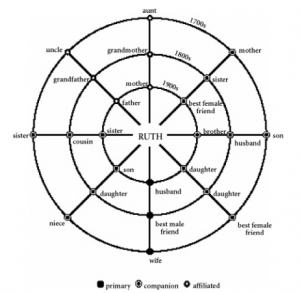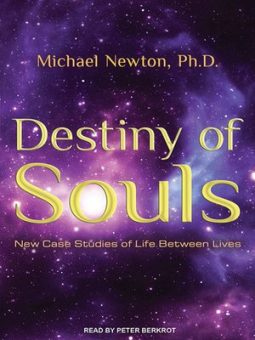Linkages Between Spiritual and Human Families
As a rule, members of the same soul group do not return in their next incarnations as members of the same genetic human family. This means, contrary to American Indian tradition, a grandfather’s soul would typically not return to the body of his grandson. I have emphasized the opposition souls have for genetic reincarnation in chapter 4 under soul division and again in chapter 5 with DNA. It is limiting and even redundant for souls who wish to learn fresh lessons to return to bodies having the same heredity, ethnicity, cultural environment, and perhaps the same geographic setting as they had in a former life. By incarnating in different families around the globe in each life, souls are able to take advantage of the great variety of human body choices. This variety is what gives depth to our incarnations on Earth.
In unusual cases, our guides may be indulgent with souls who have strong feelings about unfinished karmic business within a particular family and wish to return to the same family. These souls may be given another crack at addressing a serious wrong done to them, or to correct harm they have caused another in the family. They could return as children of a new generation, but within the same lifetime of those people who were involved with the karmic events requiring their attention. I want to stress these occurrences of genetic reincarnation for karmic purposes are rare. It is far more likely the soul would return to another family with peripheral associations to the family of their former life to redress a serious wrong. Nevertheless, this too would be a very unconventional decision, especially in cases of personal injury to the soul, because it smacks of revenge.
Although souls typically do not incarnate in the same hereditary family they had in past lives, members of the same soul group most definitely choose new families where they can be together. Members of soul groups tend to be associated in each life by blood ties and geographic proximity. What sort of roles do they choose? I’m sure readers of this book could sit down and draw up a chart showing significant members of their family, friends, lovers and even acquaintances to see who might be the most likely candidates for their own soul family.
In chapter 5, figure 7, I charted the color auras of a soul family in their current life. Figure 10 is a diagram showing how a group of souls incarnated into human families in order to stay connected to one another over the past three centuries. My central subject in this diagram is Ruth. Please note that from one century to the next, the family heredity is completely different despite the genealogical overtones of my chart. Figure 10 is an abbreviated version of Ruth’s spiritual friends in human bodies. There are six souls listed from her own cluster group and two from an affiliated group to be found in each century.
Ruth appears in the center of the diagram and each of the connecting lines from the center outward represents the same soul assuming different family roles relating to Ruth from the twentieth century back to the eighteenth century. We can see that Ruth’s primary soulmate in this life
Figure 10: Spiritual and Human Genealogy

This webbed diagram illustrates primary, companion and affiliated soulmates who have incarnated into bodies related to the lives of the subject, Ruth, over the past three centuries. Each generational line outward from the center represents the same soul in different bodies.
is her husband. In Ruth’s last life, this soul was her best friend, and in the life before, her wife when she was a male in the eighteenth century. Ruth’s primary soulmate has a halo color tinted with protective yellow while Ruth’s own halo is a mixture of white and blue tints, indicating clarity and love of learning. These primary soulmates have mated on a fairly regular basis for some 7,000 years since their first life together.
Besides the companion souls in Ruth’s soul group, I have also shown two affiliated souls from a nearby group. These souls are my subject’s current father and mother. The roles they played in the nineteenth century were her grandmother and grandfather respectively. In the eighteenth century, these same two souls were Ruth’s aunt and uncle. Ruth’s chart represents one typical client. Every soul group has its own subtle variations of human family preferences. I had a client the same week I saw Ruth who is extremely close to her mother. The mother’s soul was a member of that client’s soul group and was her sister in the life before.
Grandparents often have a great influence in our early lives as nonjudgmental confidants. I often find that a favorite grandparent in this life was a sibling or best friend in a former life. The social dynamics of intimate human contact are so powerful that in most of my cases the roles souls play in our lives and we in theirs directly bear on a group’s karmic lessons. When we are hurt by someone close to us in life, or caused them hurt resulting in alienation and separation, it is because they volunteered to teach us lessons of some sort while learning lessons themselves. These lessons better prepare both parties for future relationships, as case 47 will show.
I should also point out that peripheral roles in our lives by hundreds of affiliated souls in nearby groups may go on for generations. Because of space, I did not list all these souls on Ruth’s past life chart in figure 10. An example of one important affiliated soul not included here is a soul called Zenda, who was Ruth’s favorite teacher in the sixth grade. We found that in the last century, Zenda was a supportive next-door neighbor. In the eighteenth century Zenda was the owner of a business that employed this subject. The web design of figure 10 is appropriate when we consider all the interrelationships of people whose own lives are woven into our own.
The psychological profiles of primary, companion and affiliated souls in a client’s current and past lives is very instructive when detailed in a genealogical- type chart. In each of the three past centuries we found another leading actor in Ruth’s lives who was from an affiliated soul group. There was not space for her in figure 10 either. This soul, known as Ortier, assumed roles involving jealous, unemotional and manipulative people. She was sent to test Ruth’s trusting nature so she would learn to recover more quickly from the hurt and deal with it in a healthy manner. While this same individual would also demonstrate good qualities in human temperament, the negatives were very constant. In Ruth’s current life, Ortier is her mother-in-law. In the life before, this soul played the role of a close friend who betrayed her. There is evidence the karmic cycles with Ortier assuming roles as a protagonist will end soon for Ruth.
Ruth is a warm, passionate and tender person. Her primary soulmate has aspects of these qualities but is also tenacious, brutally frank and decisive. Many other souls in figure 10 are rather reserved and quiet. They also have character similarities of perfectionism and stubbornness.
One soul in the group is sloppy, easygoing and more complacent than the rest. He is my client’s brother, Andy, in her current life. This soul volunteered to be Ruth’s husband in the last century as a change of pace for her. During that life, Ruth’s primary soulmate chose the role of a male friend. They were so drawn to each other they had an affair that almost destroyed Ruth’s marriage with Andy. She finally realized in this past life that Andy, an uncustomary mate to be sure, was a person who opened her mind in a relaxed way to a more optimistic existence where she would learn to appreciate each day and see more humor in life to complement her naturally warm nature. Although not a great love match, Ruth found tolerance and playfulness with Andy as her husband in the nineteenth century. Meanwhile, her primary soulmate was coping with a new challenge of being married to someone else whose character was much more confrontative than Ruth’s.
I don’t wish to leave the impression that not being married to your primary soulmate is a formula for discontent. As a matter of fact, I have had clients who have deliberately alternated mates in a series of lives with three or four souls from their inner circle to meet certain challenges. Although the souls of Ruth and Andy tried this for the first time in the nineteenth century, the results were mostly positive.
Pages: 1 2 3 4 5 6 7 8 9 10 11 12 13 14 15 16 17 18 19 20 21 22 23 24 25 26 27 28 29 30 31 32 33 34 35 36 37 38 39 40 41 42 43 44 45 46 47 48 49 50 51 52 53 54 55 56 57 58 59 60 61 62 63 64 65 66 67 68 69 70 71 72 73 74 75 76 77 78 79 80 81 82 83 84 85 86




